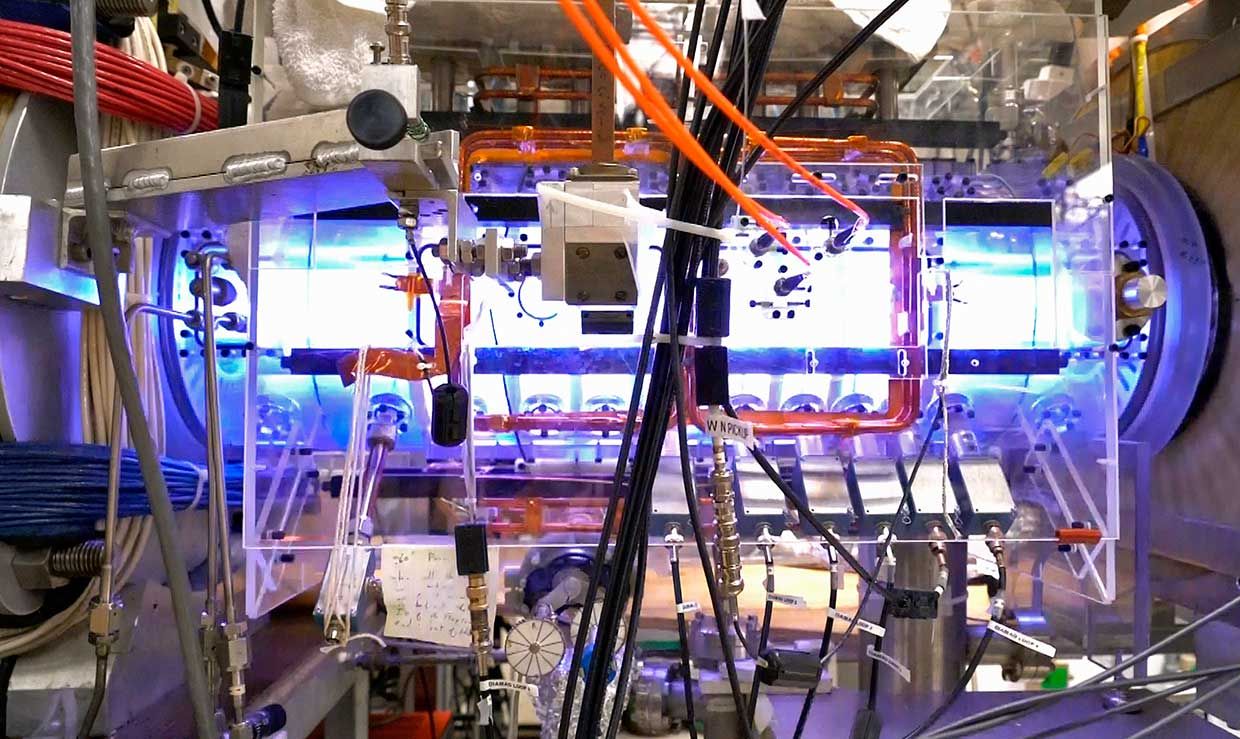Nuclear-Powered Rockets Get a Second Look for Travel to Mars
 Photo-illustration: NASA Atoms for Propulsion: Rockets powered by nuclear fission or fusion are now vying to become the preferred (and faster) means of traveling the solar system.
Photo-illustration: NASA Atoms for Propulsion: Rockets powered by nuclear fission or fusion are now vying to become the preferred (and faster) means of traveling the solar system. For all the controversy they stir up on Earth, nuclear reactors can produce the energy and propulsion needed to rapidly take large spacecraft to Mars and, if desired, beyond. The idea of nuclear rocket engines dates back to the 1940s. This time around, though, plans for interplanetary missions propelled by nuclear fission and fusion are being backed by new designs that have a much better chance of getting off the ground.
Crucially, the nuclear engines are meant for interplanetary travel only, not for use in the Earth's atmosphere. Chemical rockets launch the craft out beyond low Earth orbit. Only then does the nuclear propulsion system kick in.
The challenge has been making these nuclear engines safe and lightweight. New fuels and reactor designs appear up to the task, as NASA is now working with industry partners for possible future nuclear-fueled crewed space missions. Nuclear propulsion would be advantageous if you want to go to Mars and back in under two years," says Jeff Sheehy, chief engineer in NASA's Space Technology Mission Directorate. To enable that mission capability, he says, a key technology that needs to be advanced is the fuel."
Specifically, the fuel needs to endure the superhigh temperatures and volatile conditions inside a nuclear thermal engine. Two companies now say their fuels are sufficiently robust for a safe, compact, high-performance reactor. In fact, one of these companies has already delivered a detailed conceptual design to NASA.
Nuclear thermal propulsion uses energy released from nuclear reactions to heat liquid hydrogen to about 2,430 C-some eight times the temperature of nuclear-power-plant cores. The propellant expands and jets out the nozzles at tremendous speeds. This can produce twice the thrust per mass of propellant as compared to that of chemical rockets, allowing nuclear-powered ships to travel longer and faster. Plus, once at the destination, be it Saturn's moon Titan or Pluto, the nuclear reactor could switch from propulsion system to power source, enabling the craft to send back high-quality data for years.
Getting enough thrust out of a nuclear rocket used to require weapons-grade, highly enriched uranium. Low-enriched uranium fuels, used in commercial power plants, would be safer to use, but they can become brittle and fall apart under the blistering temperatures and chemical attacks from the extremely reactive hydrogen.
However, Ultra Safe Nuclear Corp. Technologies (USNC-Tech), based in Seattle, uses a uranium fuel enriched to below 20 percent, which is a higher grade than that of power reactors but can't be diverted for nefarious purposes, so it greatly reduces proliferation risks," says director of engineering Michael Eades. The company's fuel contains microscopic ceramic-coated uranium fuel particles dispersed in a zirconium carbide matrix. The microcapsules keep radioactive fission by-products inside while letting heat escape.
Lynchburg, Va.-based BWX Technologies, is working under a NASA contract to look at designs using a similar ceramic composite fuel-and also examining an alternate fuel form encased in a metallic matrix. We've been working on our reactor design since 2017," says Joe Miller, general manager for the company's advanced technologies group.
Both companies' designs rely on different kinds of moderators. Moderators slow down energetic neutrons produced during fission so they can sustain a chain reaction, instead of striking and damaging the reactor structure. BWX intersperses its fuel blocks between hydride elements, while USNC-Tech's unique design integrates a beryllium metal moderator into the fuel. Our fuel stays in one piece, survives the hot hydrogen and radiation conditions, and does not eat all the reactor's neutrons," Eades says.
Princeton Plasma Physics Laboratory scientists are using this experimental reactor to heat fusion plasmas up to one million degrees C-on the long journey to developing fusion-powered rockets for interplanetary travel.
 Photo: Princeton Plasma Physics Laboratory Princeton Plasma Physics Laboratory scientists are using this experimental reactor to heat fusion plasmas up to one million degrees C-on the long journey to developing fusion-powered rockets for interplanetary travel.
Photo: Princeton Plasma Physics Laboratory Princeton Plasma Physics Laboratory scientists are using this experimental reactor to heat fusion plasmas up to one million degrees C-on the long journey to developing fusion-powered rockets for interplanetary travel. There is another route to small, safe nuclear-powered rockets, says Samuel Cohen at Princeton Plasma Physics Laboratory: fusion reactors. Mainline fusion uses deuterium and tritium fuels, but Cohen is leading efforts to make a reactor that relies on fusion between deuterium atoms and helium-3 in a high-temperature plasma, which produces very few neutrons. We don't like neutrons because they can change structural material like steel to something more like Swiss cheese and can make it radioactive," he says. The Princeton lab's concept, called Direct Fusion Drive, also needs much less fuel than conventional fusion, and the device could be one-thousandth as large, Cohen says.
Fusion propulsion could in theory far outperform fission-based propulsion, because fusion reactions release up to four times as much energy, says NASA's Sheehy. However, the technology isn't as far along and faces several challenges, including generating and containing the plasma and efficiently converting the energy released into directed jet exhaust. It could not be ready for Mars missions in the late 2030s," he says.
USNC-Tech, by contrast, has already made small hardware prototypes based on its new fuel. We're on track to meet NASA's goal to have a half-scale demonstration system ready for launch by 2027," says Eades. The next step would be to build a full-scale Mars flight system, one that could very well drive a 2035 Mars mission.
This article appears in the January 2021 print issue as Nuclear-Powered Rockets Get a Second Look."